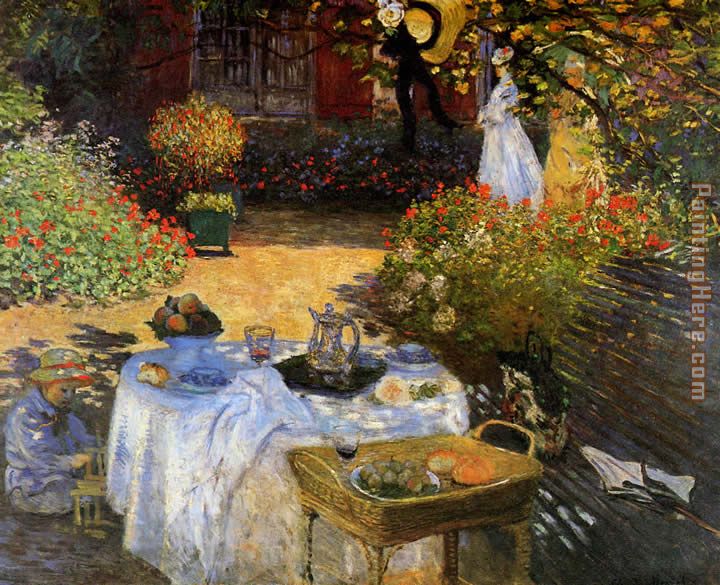Description
In "Lunch: Decorative Panel" of 1874, Claude Monet offers us an intimate and almost tangible vision of everyday life, a topic that is recurrent in his work and resonates with the ethics of impressionism. Through a carefully organized composition, Monet captures an ephemeral moment that feels at the same time familiar and deeply aesthetic.
The work shows two central figures, a man and a woman, sitting at a table. The representation of these characters is not only merely figurative; On the contrary, they are characters that emanate a sense of life, a connection that transcends the pictorial framework. Monet, known for his ability to play with light and shadow, uses these tools to give texture and depth to the scene. The light filters subtly through a curtain, illuminating the faces of the figures with a soft and natural glow, which suggests the time of lunch and the warmth of the environment. This masterful use of light is characteristic of its style and reflects the charming atmosphere of the Paris of the late nineteenth century, a period of cultural and industrial flourishing that Monet captures with an unparalleled elegance.
It is interesting to observe the color palette that Monet chooses in this work. The warm tones predominate, with a mixture of earthly colors that give life to the table and the environment without ever feeling overloaded. The brushstrokes are loose and fluid, creating a sense of movement, as if the scene could come alive at any time. This approach is a testimony of its search to capture not only the image, but the essence of an instant, an approach that moves him away from the rigid academic standards of his time.
While the figures in painting are important, it is the environment that tells its own story. The table is full of typical elements of a lunch, but it is not a simple food disposal; Rather, it is a deployment of modernity in the gastronomy of the moment, where the presentation and quality of food were beginning to be issues of interest. This detail connects painting not only with everyday life, but also with the socio -economic context of the time, where the bourgeoisie began to enjoy a more refined lifestyle.
In addition, the choice of Monet by the decorative panel format suggests an intention beyond mere representation: this type of work would be placed in a private space, suggesting the creation of a cozy atmosphere in the home. By integrating art into daily life, Monet manages to erase the lines between beauty and the everyday, a distinctive feature of his practice and impressionism in general.
The context of the work is also crucial. In 1874, Monet had already experienced with the light, color and shape in works such as "Impression, Sunrise" (1872), and "The Nenufare series" would begin to demonstrate in its future exploration. "Lunch" is at a point of convergence, where technique and theme reflect the tensions and changes of the modern world.
When contemplating "lunch", the viewer is invited to immerse himself in an instant that, although fleeting, feels eternally present. Monet's ability to capture the spirit of his time and the pulse of daily life through a vibrant palette and an ingenious composition ensures that this work remains a valuable witness of the artistic movement that transformed the course of painting. His legacy, encapsulated in this piece, continues to inspire generations of artists and art lovers equally, reminding us of the beauty that resides in the simplest moments of human existence.
KUADROS ©, a famous paint on your wall.
Hand-made oil painting reproductions, with the quality of professional artists and the distinctive seal of KUADROS ©.
Reproduction service paintings With a guarantee of satisfaction. If you are not completely satisfied with the replica of your painting, we refund your money 100%.

